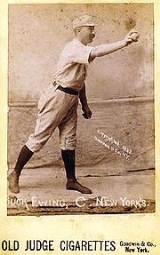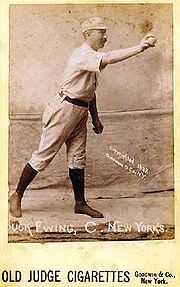
Buck Ewing
Encyclopedia
William "Buck" Ewing was a Major League Baseball
player and manager
, and is widely regarded as the best catcher
of his era and is often argued to be the best player of the 19th century. He was born in Hoagland, Ohio.
in 1880 as a member of the Troy Trojans, but rose to stardom in 1883 as a member of the New York Gothams
, later known as the Giants. That year he became the first player in major league history to hit 10 home run
s in a season (a feat he would never repeat), while batting
.303. Playing in an era when triples
were more common than home runs due to the spacious parks and poor quality of the balls used, he led the league in 1884 with 20 triples
, and was often among the league leaders.
Ewing was equally renowned for his defensive abilities. Writing in the 1938 Spalding Guide, John Foster said of him, "As a thrower to bases Ewing never had a superior, and there are not to exceed ten men who could come anywhere near being equal to him. Ewing was the man of whom it was said, "He handed the ball to the second baseman from the batter's box."
Primarily a catcher, Ewing was versatile enough to play all nine positions, which he did, and fast enough to steal 354 bases. He hit .300 in ten different seasons.
 Playing until 1897 with the Giants, Cleveland Spiders
Playing until 1897 with the Giants, Cleveland Spiders
and Cincinnati Reds
, Ewing posted consistently superb offensive numbers. Arguably his best season was in 1893 with the Spiders when he batted .344 with 6 home runs, 122 RBI
, 47 stolen base
s and 117 runs.
In 1890, when a player revolt led to the formation of the short-lived Players League
, Ewing led the New York franchise as both star player and manager. Lingering resentment in the wake of the league's establishment and demise has often been suspected as a reason for his limited play in 1891 and subsequent move to Cleveland following the 1892 season. Ewing finished his career with a .303 lifetime batting average, 71 home runs, 883 RBI, 1129 runs, 250 doubles
and 178 triples - totals made more impressive by the fact he was playing annual seasons only 100-130 games long.
In addition to playing, Ewing managed for seven seasons: the 1890 (Players League) Giants, the 1895-1899 Cincinnati Reds and the first half of the season with the 1900 Giants. He compiled a 489-395 record for a .553 winning percentage. Ewing also as used as an American Association
umpire
for two games on June 28 and July 4, .
Ewing died of diabetes in Cincinnati, Ohio
. In the first elections
to the Baseball Hall of Fame, he and Cap Anson
led all 19th century players. Three years later, in 1939
they were among the first 19th century players elected and Ewing became the first member who was primarily a catcher.
Major League Baseball
Major League Baseball is the highest level of professional baseball in the United States and Canada, consisting of teams that play in the National League and the American League...
player and manager
Manager (baseball)
In baseball, the field manager is an individual who is responsible for matters of team strategy on the field and team leadership. Managers are typically assisted by between one and six assistant coaches, whose responsibilities are specialized...
, and is widely regarded as the best catcher
Catcher
Catcher is a position for a baseball or softball player. When a batter takes his turn to hit, the catcher crouches behind home plate, in front of the umpire, and receives the ball from the pitcher. This is a catcher's primary duty, but he is also called upon to master many other skills in order to...
of his era and is often argued to be the best player of the 19th century. He was born in Hoagland, Ohio.
Biography
Ewing joined the National LeagueNational League
The National League of Professional Baseball Clubs, known simply as the National League , is the older of two leagues constituting Major League Baseball, and the world's oldest extant professional team sports league. Founded on February 2, 1876, to replace the National Association of Professional...
in 1880 as a member of the Troy Trojans, but rose to stardom in 1883 as a member of the New York Gothams
San Francisco Giants
The San Francisco Giants are a Major League Baseball team based in San Francisco, California, playing in the National League West Division....
, later known as the Giants. That year he became the first player in major league history to hit 10 home run
Home run
In baseball, a home run is scored when the ball is hit in such a way that the batter is able to reach home safely in one play without any errors being committed by the defensive team in the process...
s in a season (a feat he would never repeat), while batting
Batting average
Batting average is a statistic in both cricket and baseball that measures the performance of cricket batsmen and baseball hitters. The two statistics are related in that baseball averages are directly descended from the concept of cricket averages.- Cricket :...
.303. Playing in an era when triples
Triple (baseball)
In baseball, a triple is the act of a batter safely reaching third base after hitting the ball, with neither the benefit of a fielder's misplay nor another runner being put out on a fielder's choice....
were more common than home runs due to the spacious parks and poor quality of the balls used, he led the league in 1884 with 20 triples
Triple (baseball)
In baseball, a triple is the act of a batter safely reaching third base after hitting the ball, with neither the benefit of a fielder's misplay nor another runner being put out on a fielder's choice....
, and was often among the league leaders.
Ewing was equally renowned for his defensive abilities. Writing in the 1938 Spalding Guide, John Foster said of him, "As a thrower to bases Ewing never had a superior, and there are not to exceed ten men who could come anywhere near being equal to him. Ewing was the man of whom it was said, "He handed the ball to the second baseman from the batter's box."
Primarily a catcher, Ewing was versatile enough to play all nine positions, which he did, and fast enough to steal 354 bases. He hit .300 in ten different seasons.

Cleveland Spiders
The Cleveland Spiders were a Major League Baseball team which played between 1887 and 1899 in Cleveland, Ohio. The team played at National League Park from 1889 to 1890 and at League Park from 1891 to 1899.- 1887-1891 :...
and Cincinnati Reds
Cincinnati Reds
The Cincinnati Reds are a Major League Baseball team based in Cincinnati, Ohio. They are members of the National League Central Division. The club was established in 1882 as a charter member of the American Association and joined the National League in 1890....
, Ewing posted consistently superb offensive numbers. Arguably his best season was in 1893 with the Spiders when he batted .344 with 6 home runs, 122 RBI
Run batted in
Runs batted in or RBIs is a statistic used in baseball and softball to credit a batter when the outcome of his at-bat results in a run being scored, except in certain situations such as when an error is made on the play. The first team to track RBI was the Buffalo Bisons.Common nicknames for an RBI...
, 47 stolen base
Stolen base
In baseball, a stolen base occurs when a baserunner successfully advances to the next base while the pitcher is delivering the ball to home plate...
s and 117 runs.
In 1890, when a player revolt led to the formation of the short-lived Players League
Players League
The Players' National League of Professional Base Ball Clubs, popularly known as the Players' League , was a short-lived but star-studded professional American baseball league of the 19th century...
, Ewing led the New York franchise as both star player and manager. Lingering resentment in the wake of the league's establishment and demise has often been suspected as a reason for his limited play in 1891 and subsequent move to Cleveland following the 1892 season. Ewing finished his career with a .303 lifetime batting average, 71 home runs, 883 RBI, 1129 runs, 250 doubles
Double (baseball)
In baseball, a double is the act of a batter striking the pitched ball and safely reaching second base without being called out by the umpire, without the benefit of a fielder's misplay or another runner being put out on a fielder's choice....
and 178 triples - totals made more impressive by the fact he was playing annual seasons only 100-130 games long.
In addition to playing, Ewing managed for seven seasons: the 1890 (Players League) Giants, the 1895-1899 Cincinnati Reds and the first half of the season with the 1900 Giants. He compiled a 489-395 record for a .553 winning percentage. Ewing also as used as an American Association
American Association (19th century)
The American Association was a Major League Baseball league that existed for 10 seasons from to . During that time, it challenged the National League for dominance of professional baseball...
umpire
Umpire (baseball)
In baseball, the umpire is the person charged with officiating the game, including beginning and ending the game, enforcing the rules of the game and the grounds, making judgment calls on plays, and handling the disciplinary actions. The term is often shortened to the colloquial form ump...
for two games on June 28 and July 4, .
Ewing died of diabetes in Cincinnati, Ohio
Cincinnati, Ohio
Cincinnati is a city in the U.S. state of Ohio. Cincinnati is the county seat of Hamilton County. Settled in 1788, the city is located to north of the Ohio River at the Ohio-Kentucky border, near Indiana. The population within city limits is 296,943 according to the 2010 census, making it Ohio's...
. In the first elections
Baseball Hall of Fame balloting, 1936
The first elections to select inductees to the Baseball Hall of Fame were held in 1936. Members of the Baseball Writers Association of America were given authority to select individuals from the 20th century; while a special Veterans Committee, made up of individuals with greater familiarity with...
to the Baseball Hall of Fame, he and Cap Anson
Cap Anson
Adrian Constantine Anson , nicknamed "Cap" and "Pop", was a National Association and Major League Baseball first baseman...
led all 19th century players. Three years later, in 1939
Baseball Hall of Fame balloting, 1939
The 1939 elections to select inductees to the Baseball Hall of Fame were the last ones conducted prior to the Hall's opening that year. Needing just one addition to complete the initial goal of 10 inductees from the 20th century, members of the Baseball Writers Association of America were once...
they were among the first 19th century players elected and Ewing became the first member who was primarily a catcher.
See also
- List of Major League Baseball Home Run Records
- List of Major League Baseball players with 100 triples
- List of Major League Baseball players with 1000 runs
- List of Major League Baseball leaders in career stolen bases
- List of Major League Baseball home run champions
- List of Major League Baseball triples champions

